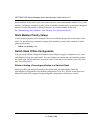
NETGEAR 7000 Series Managed Switch Administration Guide Version 7.2
Managing Switch Stacks 20-5
v1.0, May 2008
Stack Master Election and Re-Election
The stack master is elected or re-elected based on one of these factors and in the order listed:
1. The switch that is currently the stack master
2. The switch with the highest stack member priority value
3. The switch with the higher MAC address
A stack master retains its role unless one of these events occurs:
• The stack master is removed from the switch stack
• The stack master is reset or powered off
• The stack master has failed
• The switch stack membership is increased by adding powered-on standalone switches or
switch stacks
In the case of a master re-election, the new stack master becomes available after a few seconds. In
the meantime, the switch stack uses the forwarding tables in memory to minimize network
disruption. The physical interfaces on the other available stack members are not affected while a
new stack master is elected.
If a new stack master is elected and the previous stack master becomes available, the previous
stack master does not resume its role as stack master.
Stack Member Numbers
A stack member number (1 to 8) identifies each member in the switch stack. The member number
also determines the interface-level configuration that a stack member uses. You can display the
stack member number by using the show switch user EXEC command.
A new, out-of-the-box switch (one that has not joined a switch stack or has not been manually
assigned a stack member number) ships with a default stack member number of 1. When it joins a
switch stack, its default stack member number changes to the lowest available member number in
the stack.
Note: Netgear recommends assigning the highest priority value to the switch
that you prefer to be the stack master. This ensures that the switch is
re-elected as stack master if a re-election occurs.


















